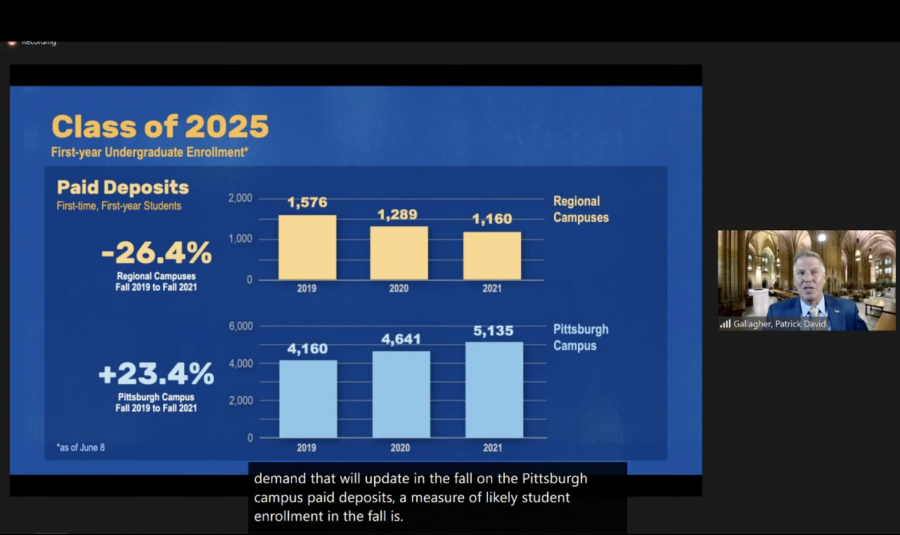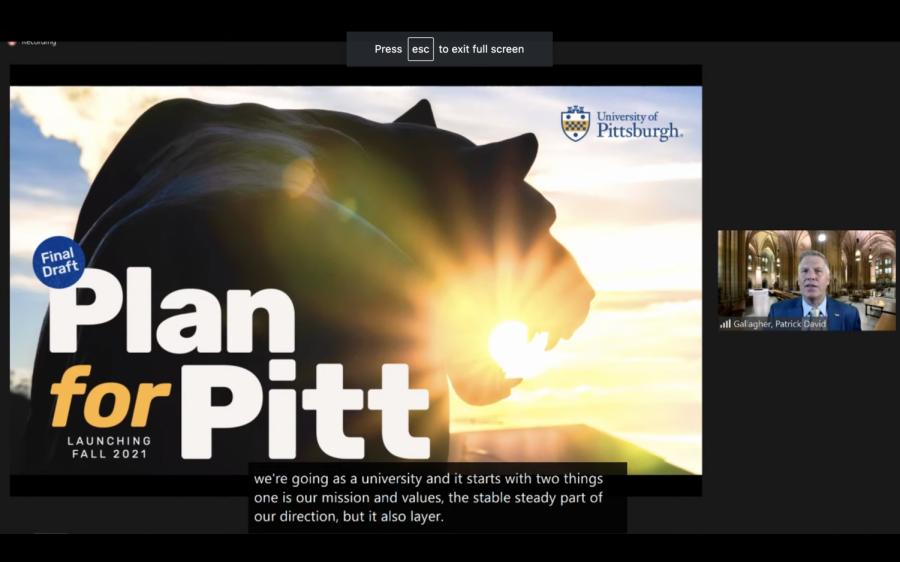Gallagher ‘strongly’ recommends, expects community to be vaccinated by fall, unveils new strategic plan
Chancellor Patrick Gallagher speaks at Friday morning’s board of trustees meeting.
June 25, 2021
Chancellor Patrick Gallagher said at Pitt’s Friday board of trustees meeting that while the University community can look forward to a more engaging fall semester, a fully normal academic year is unlikely unless those coming back to campus are vaccinated.
“So in short, next year is not back to ‘pre-COVID,’ it’s not back to fully normal,” Gallagher said. “But if most or all of us get the vaccine it will be very close to the same robust environment at Pitt that existed before this pandemic.”
Gallagher said while the University will continue to encourage students, faculty and staff to get vaccinated in preparation for the fall semester, a vaccine requirement is not in the works. Gallagher said equating the requirement of a COVID-19 vaccination with a safe campus is “unhelpful.”
In the meeting, Gallagher previewed Pitt’s plans for the fall semester, including the possibility of last year’s COVID-19 regulations — such as testing, quarantining and PPE — sticking around, assuming not all students on campus will be vaccinated. Gallagher said these regulations will likely be enforced because of this “mixed immunity,” but those who are fully vaccinated would be exempt from these requirements.
“The plans for the fall at Pitt are based on a simple fact,” Gallagher said. “We believe that the vaccines are safe, available and highly effective. We strongly recommend and expect all of our community — students, faculty and staff — to be fully vaccinated before they come back on campus for the fall term.”
Pitt spokesperson Kevin Zwick said Friday afternoon that the University will release information next week about “health and safety guidance” for the fall semester, and additional information will be provided throughout July. He added that “mitigation measures,” which he did not provide more details about, will be in place for community members who choose not to get vaccinated or are unable to.
Gallagher said while other public universities are requiring vaccines, this strategy does not ensure that all students will actually be vaccinated.
“So called mandates being reported broadly in many cases are not mandates,” Gallagher said. “A close review of announcements at schools that announced mandates show that there will be unvaccinated individuals on their campuses.”
While Pitt has no plans to require vaccinations, Pitt’s Senate Council at its May 26 meeting voted 79% in favor of mandating a COVID-19 vaccine for students, faculty and staff to be on campus. Pitt’s Student Government Board said in a statement on Monday that SGB stands in “solidarity” with the Senate Council vote.
During the meeting, Gallagher also discussed how the COVID-19 pandemic disrupted Pitt’s enrollment, such as changes to the standardized testing for admissions, travel and visa issues for international students and limitations on in-person activities like campus visits for prospective students. Gallagher said despite this, paid deposits for first-time, first-year students at Pitt’s Pittsburgh campus has gone up 23.4% since 2019, which Gallagher said is “extremely strong.”
“Clearly there is extremely strong demand,” Gallagher said. “Maybe it’s pent-up demand, maybe it’s a reflection of restored new normal demand, but it’s very high for Pitt in 2021 and there’s great excitement about the fall semester.”

Gallagher said more than 50% of applicants this past year opted for test-blind admissions. Gallagher added that there was also a record number of applicants, and the incoming class of 2025 has the potential to set records for the number of Pell-eligible students, African American/Black students, Hispanic/Latinx students, underrepresented minority students and minority students.
Turning to the long-term, Gallagher unveiled the final draft of the University’s strategic plan framework. He said the Plan for Pitt 2025 has been redeveloped in several ways — to focus on the three core pillars of people, programs and purpose; assess and fund initiatives annually; link implementation directly to the annual budget process and ensure progress is more “collaborative and coordinated.”
Gallagher said the plan is not a “top-down directive,” but instead reflects the input of students, faculty and staff from across campus to help drive the University’s future.
Pitt originally released the framework for Plan for Pitt 2025 — a plan for University development and growth over the next five years — in April 2020. The University then pushed back the plan’s release last summer to incorporate its response to the pandemic, as well as strategies to strengthen racial equity on campus.
Pitt spokesperson Kevin Zwick said the framework is “fundamentally different” than the original plan because it applies a “universal lens” of “promoting inclusion” across all of our initiatives and all three pillars.
“In doing so, the new plan effectively embeds inclusion (and our other values) into everything we do,” Zwick said.
The strategic goals for Pitt’s people are to:
- Create an inclusive and equitable campus environment — one that welcomes, values and embraces the diverse perspectives of every member of the community;
- Protect academic freedom; institutional independence; and the associated rights, responsibilities and privileges;
- Enrich the student experience with transformative opportunities to learn, grow and thrive;
- Enhance the employee experience through robust talent development as well as transformative opportunities to collaborate, engage and advance; and
- Update the physical and operational environment to encourage risk-taking, exploration and collaboration.
“Our mission is made possible by our ability to attract exceptional individuals to the University — students, faculty and staff — to learn, to teach and advance the frontiers of knowledge,” Gallagher said. “This pillar provides a place where we identify strategic goals that are about strengthening our ability to attract, retain and support those individuals, and support how they work together as a collective community dedicated to our academic mission.”
The strategic goals for Pitt’s programs are to:
- Enhance graduate and professional offerings in terms of their reputation, relevance and impact;
- Create more preeminent teaching, learning, scholarship and research experiences;
- Increase participation and presence in multidisciplinary, solution-sized research projects;
- Broaden academic opportunities to include more nontraditional students and settings; and
- Expand opportunities for civic and global engagement.
“In some ways, this is the most obvious area — these are the things we do. Our academic … activity programs, our research activities and our service and our community engagement,” Gallagher said. “Here we are defining ways to improve the quality of these programs, the reputation of these programs or the reach of these programs.”
The strategic goals for Pitt’s purpose are to:
- Extend networks and supports to help students graduate on time, secure meaningful employment and realize early career success;
- Enhance the professional trajectories and personal success of alumni;
- Fuel economic development throughout the region and economic growth throughout the commonwealth; and
- Collaborate with communities — near and far — to improve outcomes and opportunities for their residents.
“What we did here is we identified goals that define what difference does Pitt make, what is our impact,” Gallagher said. “These strategies stretch outside the University. Much of the impact happens after students graduate, or in our communities after our programs have had an impact. And here we’re clearly defining ‘How do we make the world a better place?’”
Gallagher said the work now turns to bringing the plan to life over the next five years.
“The initiatives that will help us make Pitt better — enhancing these strategic goals — will continue to evolve,” Gallagher said. “But they’re exciting and I think they push us in a direction we all want to go.”








